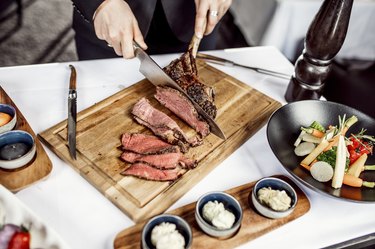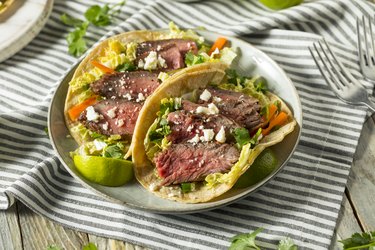
With the rise of plant-forward diets, eating conventionally raised animals has been demonized in recent years. Usually, the argument is made against meat and in favor of a plant-based lifestyle. But there is a third option that isn't often discussed: Grass-fed meat.
The health benefits of grass-fed meat make it a smart menu choice — that is, if you eat meat and your budget allows for it. Here, health experts explain why grass-fed meat is good for you and how to include it in your eating plan.
Video of the Day
Video of the Day
What Is Grass-Fed Meat?
Grass-fed meat includes mostly beef, lamb and goat.
Conventional meat is typically raised on an industrial farm called a Concentrated Animal Feeding Operation (CAFO), according to the Environmental Protection Agency. CAFOs often have crowded living conditions, and the animals are fed a diet of corn, soy, wheat and other subsidized commodities.
They may be given antibiotics and to prevent and treat infections as well as hormones to accelerate growth, according to the National Association of Local Boards of Health. (FYI, growth hormones are not approved for use in dairy cows, veal calves, pigs or poultry, per the FDA.)
In contrast, grass-fed beef and other animals are raised in a natural environment: On a pasture. The broader term "pasture-raised meat" can refer to chickens, eggs and pork as well as red meat. Pasture-raised means that the animals were raised in their natural environment with plenty of access to the outdoors. But they may or may not have been fed some grain or other feed and they may or may not have been given antibiotics and growth hormones throughout their life.
There are a few important classifications of beef that can be helpful to learn when reading labels:
- Grass-fed: Grass-fed means that the animal ate grass or forage in their lifetime with the exception of milk consumed prior to weaning, according to the USDA. Federal guidelines state that grass-fed animals must forage from grass, legumes, and/or cereal grain crops. Grass-fed animals cannot feed on grain products and must have constant access to the pasture throughout their lives.
- Grain-fed: Conventional beef production is an ever-changing industry that also lacks clearly defined parameters, according to the South Dakota State University Extension. Conventionally raised beef includes cows primarily on pasture through the weaning phase. They're fed grains and other foods for the remainder of their lives.
- Certified Organic: Designated by the Certified Organic label, animal products with this label have not been given any antibiotics or hormones. Certified Organic animals can be either grass-fed or grain-finished as long as the grain is 100 percent organic, according to USDA standards.
Why Grass-Fed Beef Is So Good for You
Red meat in general has quite a few health benefits. One 4-ounce serving of cooked grass-fed ground beef contains the following, according to the USDA:
- Calories: 190
- Total fat: 11 g
- Saturated fat: 4.5 g
- Cholesterol: 69.4 mg
- Sodium: 69.4 mg
- Total carbs: 0 g
- Protein: 23 g
1. It's Nutrient Dense
A March 2010 Nutrition Journal review suggests grass-fed beef contains more fat-soluble vitamins, like vitamins A and E, as well as inflammation-fighting antioxidants, such as glutathione and superoxide dismutase, says Veronica Rouse, RD, aka the Heart Dietitian.
Vitamins A and E are both fat-soluble vitamins that help support our immune system, skin health, vision and support growth and hormone health, according to the National Institutes of Health.
"Grass-fed meat is higher in vitamin A and E content, lower in total fat, and has a healthier omega-3 to omega-6 ratio than grain-fed meat. Plus, red meat contains bioactive compounds, including taurine for brain and muscle function, carnitine for energy, and creatine for muscle strength and performance," says Samantha Cassetty, RD, a nutrition advisor to Beef + Lamb New Zealand.
2. It May Be Less Likely to Raise Your Cholesterol
Grass-fed beef still contains saturated fat, but the type of saturated fat in grass-fed meat is different than that in conventionally raised meat.
There are three different types of saturated fat found in red meats: palmitic acid, myristic acid, and stearic acid, according to the March 2010 study in the Nutrition Journal. The first two are known to increase levels of cholesterol. The last, stearic acid, has been shown to have a neutral effect on cholesterol levels.
Grass-fed meat has higher levels of stearic acid, and a small March 2021 Clinical Nutrition study linked stearic acid to lower levels of "bad" LDL cholesterol.
3. It's Better for Your Heart
Grass-fed meat has a healthier profile of omega-3 to omega-6 ratios, according to Mayo Clinic. Omega-3 to omega-6 ratios have been well-documented to show a link to a lower risk of heart disease, per a July 2021 study in Nutrients.
Whether the animal is fed grass or grain, the omega-6 fatty acid composition stays about the same. However, it is the omega-3 fatty acids — the heart-healthy kind — that increase on a grass-fed diet, per the March 2010 Nutrition Journal study.
"Looking at grass-fed versus grain-fed beef through an integrative cardiologist's lens, there are quite a few differences," says Director of Integrative and Functional Cardiology Trent Orfanos, MD, ABIHM. "I'd recommend grass-fed beef primarily because grass-fed meat has a better ratio of omega-6 fats to omega-three fats. Omega-6 fats can increase inflammation, while omega-3 fats are healthier to consume and reduce inflammation. While grass- and grain-fed beef contain roughly the same amount of omega-6, grass-fed beef contains up to five times the amount of omega-3 fats," Dr. Orfanos tells us.
What's more, the American Heart Association recommends limiting saturated fat and eating more omega-3 fatty acids to manage cholesterol levels and to help reduce the risk of heart disease. So getting more omega-3s from grass-fed beef is a smart strategy to support heart health.
4. It’s Better for the Environment
"Not only is grass-fed meat better for you, but it's better for the planet, too," Cassetty says.
Grass-fed sheep and beef farming in New Zealand has reduced its carbon emissions and has a lower carbon footprint than conventionally raised meat, per a November 2022 report in the Environmental Impact Assessment Review. "Farming livestock on open pasture and a grass-fed diet all day, every day makes this goal possible," Cassetty says.
Grass-fed meat has another advantage: It's better for the animals. "For instance, the ability of the animals to eat and live as they would naturally is integral to their wellbeing. And grass-fed animals are generally healthier and require few, if any, drug treatments," Cassetty explains.
Grass-Fed Meat Brands to Try
Your local grocery likely has a grass-fed or pasture-raised meat section — we have seen these popping up in Walmart, Target, Costco and Aldi. If you want to buy in bulk or order from a trusted source online, check out these brands:
- ButcherBox (Starting at $99 for 7+ pounds of custom-choice meat)
- Thousand Hills (Land to Market Verified beef, priced per pound and cut)
- Teton Waters Ranch (Pre-made burgers, hot dogs, and sausages; $9.90 on Instacart)
- New Zealand Beef and Lamb (Priced per pound at Sam's Club)
- US Wellness Meats (Starting at $7.88 for grass-fed ground beef)
Tips for Cooking Grass-Fed Meat
- Grass-fed meat is often leaner, which can create tougher meat if not prepared with less heat and decreased cooking times.
- For steaks, most agree that cooking steaks on a stovetop or grill at 325 degrees Fahrenheit is the best temperature for a tender end result.
- If baking in the oven, consider decreasing the usual temperature by about 50 degrees F for best results.
- "If you're worried about the cost of grass-fed meat, you can choose a less expensive cut. For instance, grass-fed flank steak — also known as skirt steak — is the perfect cut for salads, fajitas, and stir-fries, while grass-fed lamb shoulder is a flavorful cut with a lower price point than lamb leg," Cassetty explains.
- Marinate the meat for a tender texture and better flavor. We love these easy ways to cook tri-tip steak.

